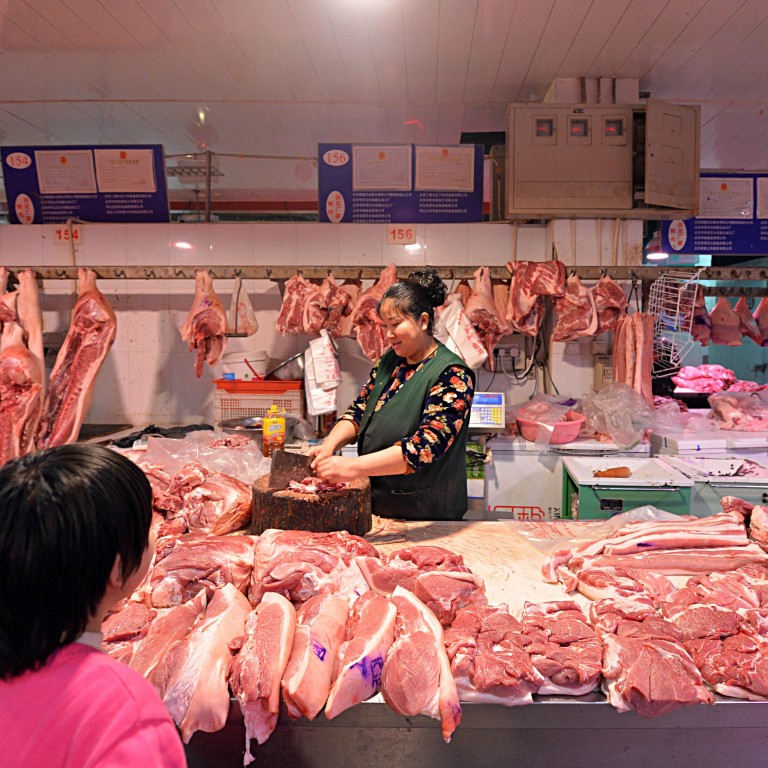
Shandong’s pig stocks dropping as deadly African swine fever hits China’s pork supply, drives up prices
- Live pig stocks in February fell by 23.2 per cent against the same month last year and 18.8 per cent from July in one of China’s largest pig farming hubs
- As of last week, a total of 114 cases of African swine fever have been reported across China since August, resulting in the cull of over 950,000 pigs
One of China’s largest pig farming hubs is suffering from a drastic drop in breeding stock that would weigh further on the country’s declining supply and drive up pork prices as more regions battle the deadly African swine fever raging across the country.
Live hog and breeding pig stocks are severely shrinking in Shandong province, one of China’s richest regions, sending prices soaring, warned the provincial animal husbandry and veterinary bureau in a statement released on its official website on Wednesday.
According to the monthly monitoring data covering more than 1,100 large-scale farms across the province, live pig stocks in February fell by 23.2 per cent against the same month last year and 18.8 per cent from July, while stock of breeding swine in the 33 main large-scale breeders fell 41.2 per cent last month, compared with July.
The data also showed both output and sales of pig feed have continued to decline since October, with the decline gathering pace last month when output tumbled by nearly 33 per cent from the same month last year.
The industry’s dismal outlook is most likely to push prices higher and trigger inflationary pressure for pork, a Chinese staple, in the world’s largest pork market.
For China’s policymakers, stabilising the price of pork – the main driver of food prices – is critical as it is the most watched indicator for the country’s consumer price index (CPI), and a fundamental factor in keeping social harmony.
“We would see an obvious shortage of pork later this year,” said Xu Gao, chief economist of Everbright Securities Asset Management. “We estimate that the CPI would jump to about 3 per cent at the end of the second quarter of this year, followed by inflation, including an obvious jump in pork prices.”
But medium and small-sized pig farms in Shandong said the reality was worse than what was officially reported. The bleak situation is also prevalent in other pig farming bases, including neighbouring Henan, Hebei and Liaoning provinces, according to industry insiders, with some expecting prices to more than double from the level in 2018 later this year.
As of last week, a total of 114 cases of African swine fever have been reported across China since August, resulting in the cull of over 950,000 pigs. The disease is fatal to pigs but not humans.
We would see an obvious shortage of pork later this year. We estimate that the CPI would jump to about 3 per cent at the end of the second quarter of this year, followed by inflation, including an obvious jump in pork prices.
Zhang Liang was forced to shut a small pig feed factory in Tancheng county in Shandong’s Linyi city in late February.
“Most of the small pig farms had been left empty because so many pigs died in December and January because of the swine fever,” he said. “Few pig farms came to buy feed, while many of them were shut down and could not pay me what was owed. I had to close the factory as a result,” Zhang said.
The tale is similar in Henan and Liaoning provinces, with prices in Henan surging 60 per cent to 16 yuan (US$2.4) per kilogram from early 2018, according to farmer Fang Xinlun who expects prices to rise to 20 yuan later this year.
“I can tell you that over 70 per cent of pig farms, especially the mid and small-sized ones, had closed in the north of Henan province,” said Fang, who runs a farm in Henan’s Zhumadian city rearing about 3,000 hogs.
“I sold 300 pigs for about 300,000 yuan in January and another 200 at the same price about a month later.
“But I dare not to expand because the swine fever is just too horrible and fatal. It’s been difficult for most small pig farms to get proper official compensation for their losses.”
Earlier this month, China made its third largest weekly purchase of pork from the United States, and on March 21 the pace of imports increased despite a significant tariff.
China’s imports of US pork this year are expected to jump 28 per cent from 1.19 million tonnes in 2018, according to the US Department of Agriculture, although the figure is unlikey to meet demand as China’s annual consumption has exceeded 52 million tonnes every year since 2012.
Everbright Securities’ Xu added that the authorities should have freed up the country's frozen pork reserves to fill the supply shortfall and ease the price rises and inflation.

